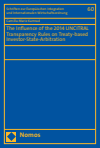The Influence of the 2014 UNCITRAL Transparency Rules on Treaty-based Investor-State-Arbitration
Zusammenfassung
Investor-Staat Streitbeilegungsverfahren haben lange Zeit hinter verschlossenen Türen stattgefunden. Aufgrund der Beteiligung von Nationalstaaten und der Tatsache, dass solche Verfahren hoch politische Kontroversen tangieren können, ist ein Mindestmaß an Transparenz zur Legitimation notwendig. Die UNCITRAL Rules on Transparency in Treaty-based Investor-State Arbitration sind ein Vorstoß zu mehr Transparenz in solchen Verfahren. In der vorliegenden Dissertation wird untersucht ob und inwieweit sich die Schiedspraxis und Nationalstaaten, bei der Verhandlung von internationalen Investitionsschutzverträgen, seit Einführung der UNCITRAL Transparenzregeln zu mehr Transparenz bekannt haben.
Abstract
Investor-state dispute settlement proceedings have taken place behind closed doors for a long time. Due to the involvement of nation states and the fact that such proceedings may affect highly political contro-versies, a minimum of transparency is required for legitimacy reasons. The UNCITRAL Rules on Transparency in Treaty-based Investor-State Arbitration are an attempt towards more transparency in such proceedings. The present dissertation examines whether and to what extent arbitration practise and nation states, when negotiating international investment agreements, have committed towards more transparency since the introduction of the UNCITRAL Transparency Rules.
Schlagworte
- 1–17 Titelei/Inhaltsverzeichnis 1–17
- 18–25 C. Chapter 1: Transparency in ISDS – overview and problem formulation 18–25
- I. What is transparency? – Terminology and definition
- II. Why is there a need for transparency in ISDS?
- 1. ISDS and public policy issues
- 2. From strict confidentiality towards more transparency
- 26–105 D. Chapter 2: The UNCITRAL Transparency Rules and ISDS 26–105
- I. Background on Investor-State Arbitration
- 1. The ICSID System
- 2. The UNCITRAL Arbitration Rules
- 3. Institutionally supported arbitration
- 4. Ad hoc arbitration
- 5. The Arbitral Proceedings in ISDS
- a) The commencement of arbitral proceedings
- b) The appointment of the tribunal
- c) The seat of the arbitration
- d) The language of the arbitration
- e) The final award
- II. Transparency in Investor-State Arbitration – developments and status quo
- 1. Advantages of transparent proceedings
- 2. Disadvantages of transparent proceedings
- 3. Third-party participation and amicus curiae submissions
- 4. Publication of documents and awards
- 5. Public hearings
- 6. Coherence and consistency
- a) Treaty interpretation by state parties
- b) The use of precedent
- c) The establishment of a permanent international investment court and an appellate mechanism
- 7. ICSIDs approach to transparency in ISDS
- 8. Other institutions and their approach on transparency
- 9. NAFTAs influence on transparency in ISDS
- a) Third party participation
- b) Public hearings
- c) Publication of documents
- d) NAFTAs influence on North American treaty practise
- e) From NAFTA to USMCA
- III. Background on the UNCITRAL Transparency Rules
- IV. The UNCITRAL TR in detail
- 1. Scope of application
- 2. Ratione temporis
- 3. Publication of information at the commencement of arbitral proceedings
- 4. Publication of documents
- 5. Submission by a third person
- 6. Submission by a non-disputing Party to the treaty
- 7. Oral hearings
- 8. Exceptions to transparency
- 9. Repository of published information
- 10. Consequences of a violation of the UNCITRAL TR
- V. The UNCITRAL TR and third-party funding
- VI. The UNCITRAL TR and their influence on commercial arbitration and on other international arbitration institutions
- VII. The transparency standard in international adjudication
- 1. International Court of Justice
- 2. WTO Dispute Settlement Body
- 3. Court of Justice of the European Union
- 4. Conclusion
- 106–121 E. Chapter 3: Transparency as a trend in international investment policies 106–121
- I. Transparency in EU Investment agreements – A European trend?
- 1. Comprehensive Economic and Trade Agreement
- 2. EU-Japan Economic Partnership Agreement
- 3. EU-Singapore Investment Protection Agreement
- 4. EU-Vietnam Investment Protection Agreement (EUVIPA)
- 5. EU-China Comprehensive Agreement on Investment
- 6. EU-United Kingdom Trade and Cooperation Agreement
- II. Influence of the UNCITRAL TR on other IIAs
- 1. BITs with India
- 2. Australian investment agreements
- 3. IIAs with Japan
- 4. Central America-Republic of Korea FTA
- 5. Hong Kong-Mexico BIT
- 6. China-Mauritius FTA
- III. Conclusion
- 122–164 F. Chapter 4: Case analyses 122–164
- I. The UNCITRAL TR and the publication of settlement agreements
- II. Cases published via the UNCITRAL Transparency Registry
- 1. OOO Manolium Processing v. Belarus
- 2. Cases against Bolivia
- a) Iberdrola, S.A. (España), Iberdrola Energía, S.A.U. v. Bolivia
- b) The Estate of Julio Miguel Orlandini-Agreda; Compañía Minera Orlandini Ltda. v. Bolivia
- 3. Alberto Carrizosa Gelzis, Felipe Carrizosa Gelzis, Enrique Carrizosa Gelzis v. Colombia
- a) Transparency provisions
- b) The redaction of footnote 11 of the non-disputing party submission
- 4. Michael Ballantine and Lisa Ballantine v. Dominican Republic
- 5. Nord Stream 2 AG v. European Union
- 6. BSG Resources Limited, BSG Resources Limited and BSG Resources SÀRL v. Republic of Guinea
- 7. Christian Doutremepuich and Antoine Doutremepuich v. Mauritius
- 8. Patel Engineering Limited v. Republic of Mozambique
- 9. Cases against Peru
- a) Gramercy Funds Management LLC and Gramercy Peru Holdings LLC v. Peru
- b) Renco Group Inc. v. Peru
- aa) Renco Group Inc. v. Republic of Peru, UNCT/13/1
- bb) Renco Group, Inc. v. The Republic of Peru, PCA Case No. 2019-46
- c) Bacilio Amorrortu (USA) v. Peru
- 10. Rand Investments Ltd. and others v. Serbia
- III. Conclusion
- 165–170 G. Chapter 5: Conclusion and prospects 165–170
- 171–180 References 171–180
- 181–188 Online Resources (accessed 7 June 2021) 181–188
- 189–194 Table of Cases 189–194


